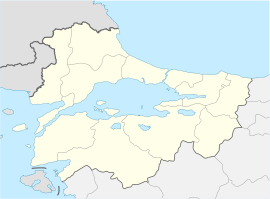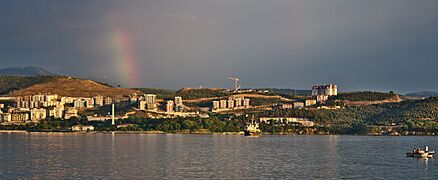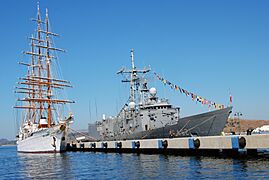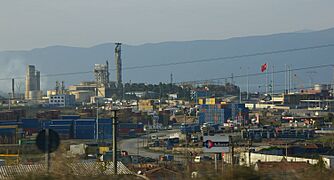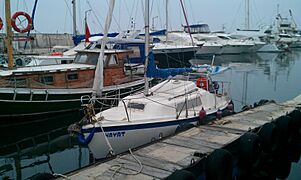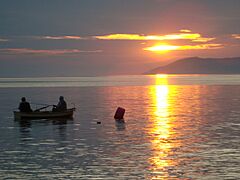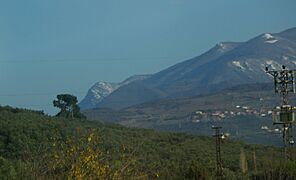Gemlik facts for kids
Quick facts for kids
Gemlik
|
|
|---|---|
|
Settlement
|
|
 |
|
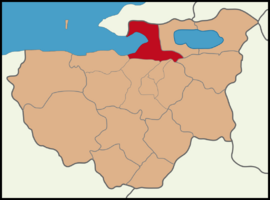
Map showing Gemlik District in Bursa Province
|
|
| Country | Turkey |
| Province | Bursa |
| Area | 401 km2 (155 sq mi) |
| Elevation | 22 m (72 ft) |
| Population
(2022)
|
120,245 |
| • Density | 299.9/km2 (776.6/sq mi) |
| Time zone | TRT (UTC+3) |
| Postal code |
16600
|
| Area code | 0224 |
Gemlik is a town and district in Bursa Province, Turkey. It covers an area of 401 square kilometers and had a population of 120,245 people in 2022. Gemlik is located on the eastern side of the Gulf of Gemlik, which is a part of the Sea of Marmara. It's about 29 km (18 mi) away from the city of Bursa.
Gemlik is an important port city with many factories. It also has a special trade area called a free zone. The port of Gemlik is one of the busiest ports in Turkey for bringing in goods. Gemlik is also very famous for its delicious black olives.
Contents
What's in a Name?
During the time of the Ottoman Empire, the town was called Gemilik. This name means "shipyard" in English. It was named this because there was a shipyard in the town that built large sailing ships called Galleons for the Ottoman Navy.
A Look Back in Time
Gemlik's Ancient Past
Long, long ago, Gemlik was the site of an ancient Greek city called Cius (pronounced "SIGH-us"). Later, it was renamed Prusias on the Sea. This city was very old and was mentioned by famous ancient writers like Herodotus and Xenophon.
Cius was built in a great spot at the top of a gulf, which made it an important trading port. People believed that Hylas, a friend of the hero Heracles, was taken by nymphs here while getting water. Another story says that Cius, also a friend of Heracles, founded the city after returning from a long journey.
The city of Cius was captured by the Persians in 499 BCE. Later, it was destroyed by Philip V of Macedon in a war. But then, King Prusias I of Bithynia helped rebuild it and renamed it Prusias. Even after being renamed, people still sometimes called it Cius. It was a key stop on the ancient Silk Road and became a very rich town because of trade.
Cius was also one of the first places to have a Christian bishopric (a church district led by a bishop). Its bishops attended important early Christian meetings. The town became part of the Ottoman Empire in 1333.
More Recent History
From 1867 to 1922, Gemlik was part of a larger area called Hüdavendigâr vilayet. In 1891, most of the people living in Gemlik were Greeks, along with some Turks, Armenians, and foreigners.
After a war, in 1922, many Greek citizens living in Gemlik moved to Greece. This was part of a big population exchange agreement between Turkey and Greece.
Where is Gemlik?
Gemlik is built on a flat area surrounded by mountains on three sides. The Samanli Mountains stretch from the southeast to the northwest. There's a big flat plain that goes from the eastern part of Gemlik all the way to the coast.
The Karsak Stream, which starts at Lake Iznik, flows through this plain and divides the town center into two parts. The Gulf of Gemlik is about 35 km (22 mi) long and 10–15 km (6–9 mi) wide. It's about 100–150 meters (330–490 ft) deep. This gulf was once used for docking ships, but now it's also a popular place for tourists.
The countryside around Gemlik is mostly covered with olive trees and pine trees on the Samanlı Mountains.
Neighborhoods
Gemlik District has 35 different neighborhoods:
- Adliye
- Ata
- Balıkpazarı
- Büyükkumla
- Cihatlı
- Cumhuriyet
- Demirsubaşı
- Dr.Ziya Kaya
- Engürücük
- Eşref Dinçer
- Fevziye
- Fındıcak
- Gençali
- Güvenli
- Halitpaşa
- Hamidiye
- Hamidiyeköy
- Haydariye
- Hisar
- Karacaali
- Katırlı
- Kayhan
- Küçükkumla
- Kumla
- Kurşunlu
- Kurtul
- Muratoba
- Narlı
- Orhaniye
- Osmaniye
- Şahinyurdu
- Şükriye
- Umurbey
- Yeniköy
- Yenimahalle
Gemlik's Weather
Gemlik has a Mediterranean climate. This means it has cool and rainy winters, and hot and dry summers. The driest month is usually July, and the wettest is December. In the higher parts of the district, the climate can be a bit different, more like an Oceanic climate.
The highest temperature ever recorded in Gemlik was 42.6°C (108.7°F), and the lowest was -10.0°C (14.0°F). The warmest month is July, with an average temperature of 23.3°C (73.9°F), and the coldest is January, with an average of 5.8°C (42.4°F).
Fun Things to Do (Tourism)
Kumla is one of the most popular holiday spots in the Marmara region during summer. Many people from Istanbul like to visit Kumla because it's close by. There are also smaller resorts like Büyükkumla, Karacaali, and Narlı along the northern coast of the gulf.
You can also visit the Sudüşen waterfall, which is north of Haydariye village. Gemlik hosts a moto-cross tournament at Şahintepe point in the Samanlı Mountains and an Olive Festival in the city during August and September.
How Gemlik Makes Money (Economy)
Gemlik is a busy place for industry. Factories here make things like plastic, textiles, marble, chemicals, machinery, car parts, steel, and fertilizers. Many of the big factories are located along the western coast, especially in the free trade zone.
About 80% of the people living in the town center work in trade. Selling olives, olive oil, and soap are very important businesses. Olive production is a huge part of Gemlik's economy.
Turkey's first cannery (a factory that cans food) was started in Gemlik. Because of this, growing vegetables like beans, artichokes, cucumbers, tomatoes, peas, eggplants, and peppers has become very popular in the area.
A lot of Gemlik's money comes from farming and industry. Even though olive trees cover a large area, they bring in a lot of money for the region. Gemlik's olives are not just sold in Turkey but also exported to other countries.
There are also two smaller industrial areas in the district. The free zone has many companies, both Turkish and foreign, and employs thousands of people.
Important factories in Gemlik include Borçelik, Borusan, and the new TOGG Turkish national car factory, which is currently being built. Many international companies also have facilities here.
The main products Gemlik exports are cars and car parts, iron and steel, electronics, textiles, and marble. The top countries that buy goods from Gemlik are Germany, Romania, Spain, France, and England.
There are 5 ports in Gemlik, which handle many ships, passengers, and vehicles coming in and out.
News and Media
Gemlik has several local news sources:
- Gemlik Haberci (Gemlik's first news website)
- Gemlik Gazetesi (the first newspaper in Gemlik, started in 1958)
- Gemlik Haber Gazetesi (a daily newspaper)
- Gemlik Körfez Gazetesi (the first daily newspaper in Gemlik)
- Gemlik Gündem Gazetesi (a daily newspaper)
- Gio Detay Dergi (a monthly news magazine)
- Gemlik Life (a digital newspaper)
- Gemlik Haber (internet news)
Sports Teams
Gemlik has several sports clubs:
- Gemlik Basketbol (a basketball team in Turkey's first league)
- Gemlikspor (football)
- Umurspor
- Körfezspor (football)
- Zeytinspor (basketball)
- Gücümspor (basketball)
- Çotanakspor (football)
- Karadenizspor (football)
Gallery
Famous People from Gemlik
- Giannis Papaioannou (1913–1972), a Greek singer and composer.
- Celâl Bayar (1883–1986), the 3rd President of the Republic of Turkey. He was born in the town of Umurbey.
Friendship Cities
Gemlik has "sister city" relationships with:
 Lauderhill, Florida, United States
Lauderhill, Florida, United States Novadari, Romania
Novadari, Romania
See also
 In Spanish: Gemlik para niños
In Spanish: Gemlik para niños



